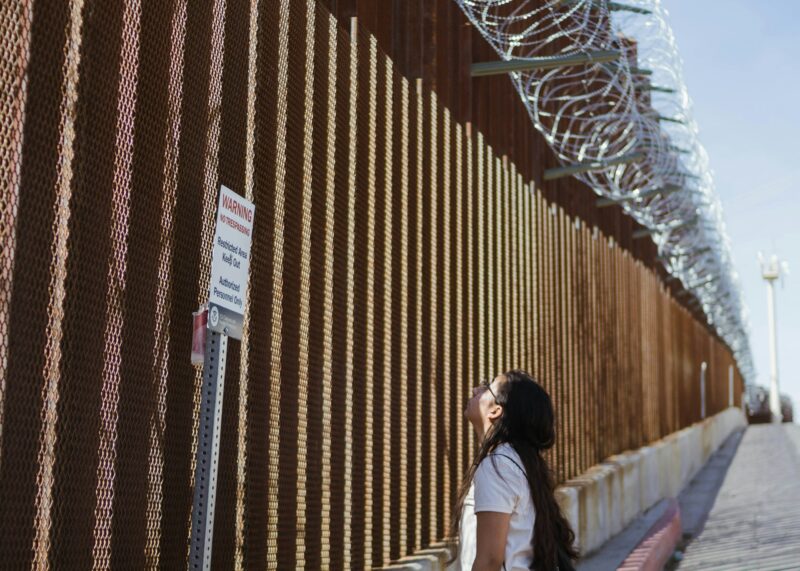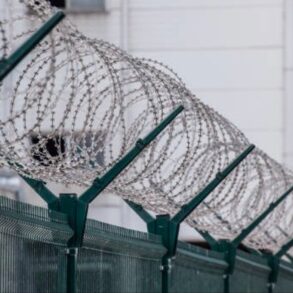
Border wall divides the town of Nogales in two. This photo was taken on the US side of the border. Image by Annika Gordon on Unsplash. Used under an Unsplash License.
This article was originally published in Russian on March 25, 2025, on Baikal People. Global Voices translated the article, edited it for clarity, and is republishing it with permission. People’s names have been changed for safety.
In the spring of 2024, US authorities began sending Russians who crossed the US–Mexico border to request political asylum into detention centers en masse. These centers are, in fact, immigration prisons, where people fleeing persecution in their homeland are often denied legal assistance, subjected to mistreatment by guards, and suffer from unsanitary conditions. At the moment, in detention centers scattered across different states, there may be from 900 to several thousand Russian citizens.
Since 2020, 29-year-old Tumen Obogoyev from Ulan-Ude had worked as one of the writers and editors for the US-owned website “The Fight Site,” dedicated to martial arts. On October 18, 2023, he entered the US with his wife, intending to request political asylum after failed attempts to obtain a talent visa.
As of April 2025, a year and a half after crossing the border, Obogoev is still in custody.
While Obogoev is in detention, his 31-year-old wife, Adiso Budaeva, is waiting in Chicago for her asylum hearing. Budaeva and Obogoev left Buryatia in March 2022, after Russia launched its invasion of Ukraine. The couple say they had disagreed with the government’s policies before, but the start of the war was the final straw.
“The reason for the invasion was initially formulated as the ‘denazification’ [of Ukraine]. For us, Buryats — people who have been discriminated against since childhood based on our ethnicity in Russia — it was complete absurdity,” Budaeva says.
The couple fled to Mongolia, anticipating repression and military mobilization, which indeed started to happen only six months later. Tumen continued working for the US site and prepared documents to apply for an O-1 “extraordinary ability” visa to the US. The lawyer’s services to prepare the visa application cost the couple USD 10,000. But Tumen was denied the visa. Then the couple decided to cross the US border and request political asylum.
In summer 2023, Obogoev and Budaeva arrived in Mexico. At the border, they presented return tickets and a travel plan through the country, like regular tourists. They installed the CBP One app on their phones and tried to secure an appointment every morning. After two months of attempts, they were scheduled for an interview with an immigration officer at 8 a.m. on October 18, 2023, at the Matamoros crossing point.
The couple arrived at the crossing at six in the morning. When it was their turn, they and other migrants were brought into a large hangar, where men and women were separated (exceptions were made only for families with children).
After a few hours, the group of men, including Obogoev , were taken somewhere. Soon after, Budaeva was called in to see the immigration officer: her passport was scanned, fingerprints taken, she was granted entry into the US and given a court summons. At 1:30 p.m., Budaeva walked out of the checkpoint into the US, in the town of Brownsville, Texas. But she couldn’t find her husband on US territory. Budaeva contacted Obogoev’s US colleagues, and they were able to find out that he had indeed been detained.
Before the war, Russians rarely sought asylum in the US. According to TRAC data, in the decade from 2011 to 2021, US immigration courts received 11,146 political asylum cases involving Russian citizens. In 2022 alone, that number rose to nearly 16,000, and, in 2023, to 42,500.
According to journalist and activist Alexandra Garmazhapova (designated a foreign agent in Russia), the idea of emigrating to the US had already circulated among residents of Buryatia even before 2022: “Sometimes, several families would leave from one village to the United States, and that became a more well-trodden path.” One of the grounds for asylum is racial discrimination. If Buryat immigrants had faced ethnic attacks back home, that could be used as justification for political asylum.
In fall 2023, around the time Tumen Obogoyev was taken to detention, the first reports emerged of mass detentions of Russians at the border. At that time, however, women and families with children were not being sent to detention centers. The mass detentions briefly stopped, but resumed in spring 2024.
According to immigration attorney Tatyana Edwards-Behar, Russian asylum seekers were repeatedly caught using fraudulent cases: “There was a growing sense that, along with real cases, there were also fake applicants — Wagner mercenaries, for example. The authorities [in the US] just don’t know how many Wagner members might have come here pretending to be draft dodgers or people who truly had a civil protest stance against the regime and the war.”
There was no official confirmation of a ban on Russians, but, in June 2024, the media obtained what was allegedly a Customs and Border Protection (CBP) memorandum stating that not only Russian citizens, but also those from Georgia, Moldova, Kyrgyzstan, Tajikistan, and Uzbekistan were placed into a separate category. According to Yulia Nikolaeva, these are countries whose citizens cannot be released “on parole” — i.e., allowed to wait for their court hearings while free. These countries are marked as “extremely difficult to deport to” because they do not cooperate with the US in the deportation process.
Aldar Tsympilov, 29, from Ulan-Ude crossed the Mexico–US border in the summer of 2024. For six years, he had lived illegally in South Korea, where he had gone for work. He was unable to legalize his status there. He feared returning to Russia because of the military mobilization that had begun: before leaving, he had served under contract in the Russian military. Aldar decided to cross the US–Mexico border, even though he knew Russians were often being detained. He tried to hedge his bets by hiring a lawyer in advance, but ran into difficulties.
He was detained at the border along with two other people from post-Soviet countries and, four days later, was transferred to a detention center in the state of California. There, he contacted lawyers whose phone numbers were passed to him by fellow detainees:
They said that last year this ban lasted three months, and maybe this year it’ll also be about three months. For now, don’t file any documents, because if we do, the case will move forward and it’ll be hard to get out from there.
On October 18, 2023, while Adiso Budaeva waited for her husband at the border crossing, Tumen Obogoev was undergoing the intake process. He and another man with a Russian passport were placed into “a freezing cell about one and a half square meters in size,” given sleeping mats and thin blankets “that looked like plastic roasting sleeves.” After 30 hours, he was transferred to the Port Isabel detention center in Texas.
Obogoev was placed in a cell within the barracks built for 70 people, designed so that guards could watch the detainees 24/7.
Poor conditions in detention centers are a topic regularly raised by US media and human rights organizations. For example, according to a joint report by the American Civil Liberties Union, Physicians for Human Rights, and American Oversight, out of 52 deaths in detention between 2017 and 2021, 49 could have been prevented had the detainees received timely medical care.
According to Garmazhapova, president of the Free Buryatia Foundation (named an extremist and “foreign agent” organization in Russia), the foundation had helped several people reach the US after they sought assistance in fleeing mobilization. Asylum was also requested by people who had spoken out against the war during the “Buryats Against War” campaign or volunteered with the foundation. Now, should they be deported, they might find themselves in serious danger — especially since 2024, when the Free Buryatia Foundation was labeled a “terrorist organization.”
Some immigrants still manage to be released before their asylum hearings. For instance, Aldar Tsympilov was lucky to end up in a California detention center, where — thanks to a court precedent from ten years ago — a judge was able to release detainees after six months in custody. Tsympilov was released on bail of US 7,500, paid by the charity organization Border Angels, which he learned about while in detention.
In some cases, detainees are released if they have a sponsor in the US with sufficient income to vouch for them, but this method now barely works. Budaeva managed to find a sponsor for her husband, but he was still not released. She explained:
The decision ultimately rests with the immigration officer, whose job (at the moment) is essentially not to let people out. If the officer decides that a person can be released, they will be released. If not, they’ll stay detained until the very end
On January 20, 2025, when Donald Trump officially assumed the presidency of the United States, obtaining asylum became more difficult for citizens of all countries. Combating illegal immigration was one of the main points of his campaign platform — and he delivered on it. In the first hours of his term, Trump shut down the CBP One app, which had granted asylum seekers legal access to the border.
Journalist Anastasia Lisova, 47, together with her family, crossed the border in December 2023, fleeing government persecution. Lisova was born and lived for many years in Buryatia, worked as an independent election observer for the Navalny HQ (the volunteer organization of Alexey Navalny, former leader of Russian opposition murdered while in Russian prison in February 2024) and the election monitoring Golos movement (labeled a foreign agent), and, after the war began, wrote posts for an anti-war Telegram channel. Although all family members submitted asylum claims in court, received work permits, and her youngest daughter started attending American school, they are now also not protected from expedited deportation.
“Right now, nothing is really clear, but it’s very scary, because you trusted the US government, came here in good faith, sat in Mexico for four months, spent a lot of money, nerves, and so on. You did everything honestly, exactly as the US government told you to. And now it turns out, you’re labeled a criminal,” says Lisova.
When Tumen Obogoev ended up in detention, the average cost of hiring an immigration lawyer, he says, had skyrocketed to USD 15,000. Obogoev decided to represent himself in court as his English was good enough to write articles for American media.
Despite bringing in representatives from two anti-war Buryat organizations and an anthropologist from Georgetown University who specializes in Siberian regions, and submitting a document package “four inches thick” supporting his case, the judge denied his asylum request.
Obogoev quotes one of her statements:
The respondent is so intelligent that he was able to avoid persecution by the Russian government for nearly two years in the past and can continue to do so in the future after returning, therefore he is safe to return.
Obogoev filed an appeal with the help of lawyers he and his wife ultimately decided to hire. Adiso and Obogoev have made no plans for what to do if he loses the appeal. Normally, immigrants are deported to their country of origin. By law, within 90 days — but in reality, the wait often drags on.
This post was originally published on this site be sure to check out more of their content.








